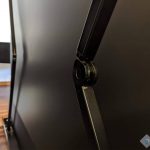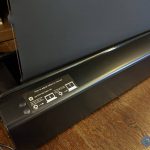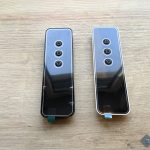I vantaggi della videoproiezione
Mai come in questo periodo l’occasione è stata più ghiotta per acquistare un videoproiettore o rinnovare il proprio impianto home theater. Il crollo verticale dei prezzi dei televisori 4K di grandi dimensioni, infatti, ha costretto i principali produttori di videoproiettori a rivedere al ribasso il proprio listino prezzi consentendo l’accesso a questo tipo di prodotti ad una fascia sempre più ampia di utilizzatori.
Sono sufficienti infatti appena 1500/2000 euro per portarsi a casa un proiettore 4k come ad esempio questo Epson TW7000 e uno schermo motorizzato e godere appieno dell’esperienza home cinema.
Inutile girarci attorno: l’esperienza di un film o di un videogames su di uno schermo di grandi dimensioni, diciamo intorno ai 100″ è esaltante e può trasformare completamente il vostro modo di godere di film e telefilm.
Venuto meno l’ostacolo economico esiste tuttavia ancora un problema per coloro che intendono trasformare la propria visione casalinga in una esperienza cinematografica: la luminosità dell’ambiente di proiezione. Escludendo il caso di sale video dedicate, appannaggio ancora di pochi fortunati, l’ambiente in cui con tutta probabilità andrete a configurare il vostro Home Cinema, infatti, è il salotto di casa. In questi ambienti il principale nemico della videoproiezione è rappresentato dalla luminosità ambientale proveniente da fonti luminose esterne, come finestre o abbaini, oppure da fonti artificiali come i lampioni stradali o le insegne luminose, la cui luce filtra attraverso le finestre anche nelle ore più buie. Ma non solo. Vi siete mai chiesti perchè le sale cinematografiche hanno pareti e soffitti dipinti di nero? Perchè il nero assorbe la luce, anche quella proveniente dallo stesso proiettore, impedendo che questa possa essere riflessa dalle pareti o dal soffitto e disturbare la visione. Tutti questi elementi, compreso il colore delle pareti e dei soffitti di cassa, rendono più difficile, se non impossibile nelle ore diurne, godersi il proprio impianto Home Cinema.
Grazie a Vividstorm, leader mondiale nella produzione di schermi per la videoproiezione tuttavia, anche questo ostacolo potrebbe essere superato. In questa recensione infatti ci occuperemo di uno schermo sviluppato dalla compagnia utilizzando materiale d’avanguardia, in grado di riflettere la quasi totalità dell’ “inquinamento luminoso” presente nella stanza, sia esso proveniente dall’alto oppure dai lati (come ad esempio nel caso di quello filtrato attraverso una finestra posta ai lati).
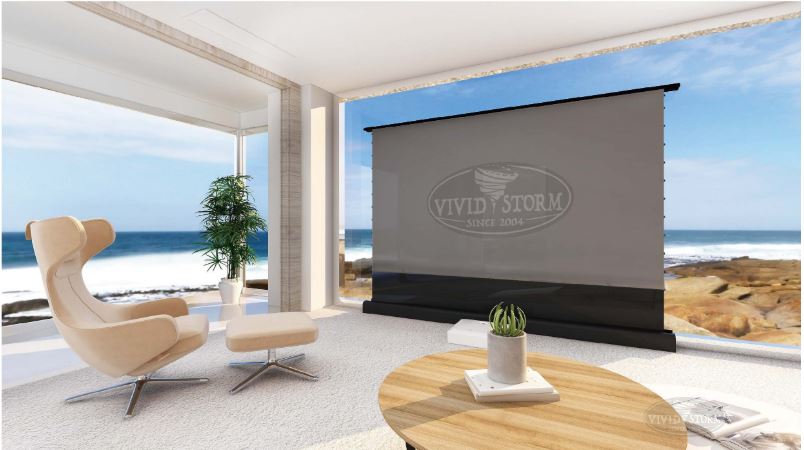 Vividstorm PRO Electric Tension Floor Screen: lo schermo e il setup ideale.
Vividstorm PRO Electric Tension Floor Screen: lo schermo e il setup ideale.
L’oggetto di questa prova è uno schermo motorizzato da pavimento pretensionato specificamente destinato ai proiettori Ultra short Throw (tiro ultra corto). In questi dispositivi, lo schermo fuoriesce da una sottile cornice metallica di colore nero posta sul pavimento, nel nostro caso non più spessa di 13 cm, che pertanto può essere facilmente occultata sul retro di una parete attrezzata moderna o su di una mensola bassa. Lo schermo in questo modo risulta completamente invisibile quando avvolto nella cornice metallica, amplificando l’effetto “wow” quando lo stesso magicamente comparirà, dispiegandosi in tutta la sua bellezza al centro del vostro angolo media. Questo tipo di schermi “da pavimento”, se abbinato ad un proiettore a tiro ultra corto, come quello utilizzato per questa prova, non richiede inoltre per la sua installazione alcuna fatica: niente trapani, passaggio di cavi o altre incombenze che potrebbero far andare su tutte le furie la vostra compagna: per la vostra esperienza home cinema da salotto basta posizionare il proiettore sotto lo schermo e il gioco è fatto.
Design
Lo schermo, come dicevamo, è del tipo “pretensionato” da pavimento. Si tratta di una categoria di schermi per videoproiezione di qualità più alta rispetto a quelli tradizionali, innanzitutto perchè essendo posizionati sul pavimento hanno bisogno di un meccanismo più complesso per l’apertura rispetto a quelli ad avvolgimento dall’alto. Ed in secondo luogo perchè questo Vividstorm dispone di un meccanismo di pretensionatura in grado di garantire la perfetta tensione del pannello di proiezione evitando che con il tempo si formino strane pieghe e avvallamenti in grado di compromettere la visione.
In particolare lo schermo Vividstorm funziona grazie a due bracci metallici, ciascuno di essi composto da due elementi che ruotano su di una ruota meccanica, che vengono azionati da un piccolo argano elettrico. Grazie a questo meccanismo l’altezza dello schermo e quindi della fascia nera inferiore, può essere regolata con precisione con il telecomando o con un piccolo strumento, incluso nella confezione. Il tempo necessario alla completa apertura dello schermo è di circa 35 secondi, quindi poco più di un minuto sono necessari per aprire e riavvolgere completamente lo schermo.
Dotazione completa
Lo schermo viene inoltre fornito con due telecomandi, il primo, di colore bianco, con tecnologia RF ovvero a radiofrequenza, e per questo con una portata molto più ampia, il secondo, nero, con tecnologia IR ovvero ad infrarosso. Entrambi i telecomandi oltre ad essere di una fattura eccellente, hanno una batteria ricaricabile integrata che permette di ricaricarli tramite una normale porta USB: una cosa molto utile rispetto agli altri telecomandi che abbiamo visto in altri schermi di videoproiezione. La dotazione dello schermo è quanto mai completa, oltre ai citati due telecomandi con relativo dispositivo di fissaggio a parete, nella confezione è presente anche un pennellino per spolverare delicatamente lo schermo e soprattutto quella che all’apparenza è una piccola pennetta USB ma che in realtà è un trigger wireless (nella confezione sono presente anche due batterie aggiuntive) che permette di sollevare lo schermo direttamente all’accensione del proiettore senza dover usare il telecomando.
Quanto alle dotazioni di sicurezza, lo schermo dispone di un sensore che permette di salvaguardare il motore di pretensionamento e avvolgimento che, nel caso rilevi ostacoli che impediscano allo schermo di fuoriuscire liberamente, arresta il motorino elettrico, evitando che lo stesso si bruci. Sul fondo inoltre quattro piedini aggiuntivi ripiegabili, alle due estremità dello schermo, consentono di allargare la base di appoggio dello stesso evitando che lo stesso possa ribaltarsi se toccato accidentalmente.
Lo schermo VividStorm in prova è espressamente studiato per la proiezione a tiro ultra corto anche se risulta utilizzabile anche con proiettori posizionati frontalmente. Non risulta utilizzabile, in questo particolare modello, (per il tipo di tecnologia utilizzata, come vedremo fra poco) con proiettori collocati sul soffitto. Nelle due immagini di seguito trovate utili informazioni per il setup del vostro schermo Vividstorm. Per la prova di questo schermo abbiamo utilizzato un proiettore a tiro ultra corto FHD BenQ W1600UST, utilizzando l’intera area di proiezione da 100″.

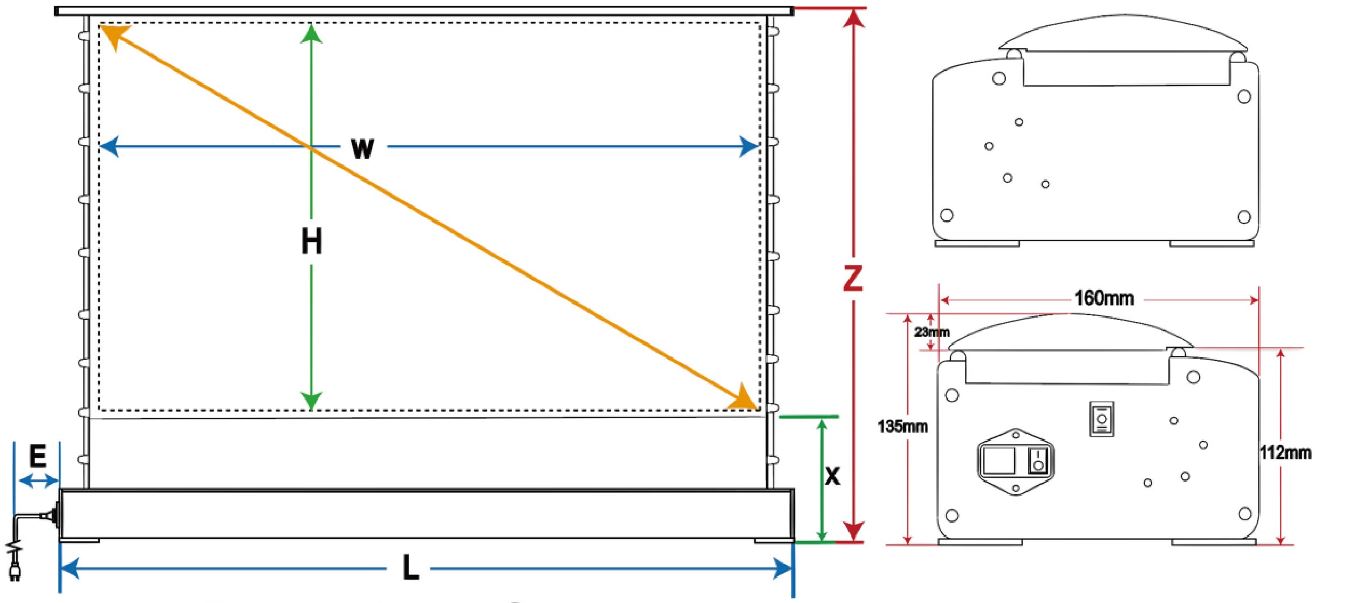
Tecnologia di proiezione.
Il tessuto utilizzato da Vividstorm per il suo schermo motorizzato da pavimento denominato OPAL è del tipo Ambient Light Reflecting (ALR). La caratteristica principale di questo tipo di tessuto artificiale è la presenza di sottilissime scalanature in grado di riflettere verso lo spettatore unicamente la luce proveniente dalla parte frontale e dal basso, dove presumibilmente verrà posto il proiettore (nel caso dell’UST necessariamente dal basso) e di deviare riflessi e luminosità indesiderata proveniente dall’alto o dai lati, impedendo che questa interferisca con l’immagine proiettata. Oltre alla particolare trama del tessuto tecnico (PVC) utilizzato, una particolare importanza per questo tipo di schermi assume la tecnica di realizzazione, ed ecco perchè questo tipo di schermi viene realizzato solo da produttori altamente specializzati come Vividstorm ed ha un costo decisamente superiore, anche del 100%, rispetto ai tradizionali schermi non ALR. Nel nostro caso il prezzo dello schermo in prova si aggira intorno ai 1300 euro, una cifra elevata ma che, stando alla nostra esperienza, è assolutamente giustificato dalla resa finale.
 Lo schermo è realizzato mediante l’applicazione di diversi strati di vernice grigia, inodore e non tossica, contenente microscopiche particelle di metallo che, riflettendo la luce, aiutano a recuperare la perdita di luminosità dovuta all’utilizzo di una colorazione assorbente come il grigio, anzichè riflettente come il bianco. L’applicazione di questo tipo di vernice è resa ancora più complicata dalla necessità che l’intero schermo di proiezione mantenga una sostanziale uniformità soprattutto per quanto riguarda la distribuzione di queste particelle metalliche, evitando che alcune zone dello stesso risultino più scure delle altre o più luminose, creando il terribile effetto “macchia di unto” o per usare un termine tecnico più adeguato, l’effetto “hotspot”. Questo effetto hotspot può risultare ancora più evidente quando si utilizzano proiettori a tiro ultra corto, ed ecco perchè, in questi casi, è fondamentale affidarsi ad aziende ad elevata specializzazione.
Lo schermo è realizzato mediante l’applicazione di diversi strati di vernice grigia, inodore e non tossica, contenente microscopiche particelle di metallo che, riflettendo la luce, aiutano a recuperare la perdita di luminosità dovuta all’utilizzo di una colorazione assorbente come il grigio, anzichè riflettente come il bianco. L’applicazione di questo tipo di vernice è resa ancora più complicata dalla necessità che l’intero schermo di proiezione mantenga una sostanziale uniformità soprattutto per quanto riguarda la distribuzione di queste particelle metalliche, evitando che alcune zone dello stesso risultino più scure delle altre o più luminose, creando il terribile effetto “macchia di unto” o per usare un termine tecnico più adeguato, l’effetto “hotspot”. Questo effetto hotspot può risultare ancora più evidente quando si utilizzano proiettori a tiro ultra corto, ed ecco perchè, in questi casi, è fondamentale affidarsi ad aziende ad elevata specializzazione.
 Il tessuto, a richiesta, può essere ottenuto sia con gain di +0,6 (quello della nostra prova), un guadagno questo particolarmente indicato per i proiettori a tiro ultra corto, dove non è necessario salvaguardare la luminosità del proiettore, considerata la vicinanza dello stesso allo schermo, sia in versione con gain +0,8, più indicata invece per proiettori tradizionali. Si tratta quindi, in entrambi i casi, di uno schermo grigio cosiddetto ad altro contrasto.
Il tessuto, a richiesta, può essere ottenuto sia con gain di +0,6 (quello della nostra prova), un guadagno questo particolarmente indicato per i proiettori a tiro ultra corto, dove non è necessario salvaguardare la luminosità del proiettore, considerata la vicinanza dello stesso allo schermo, sia in versione con gain +0,8, più indicata invece per proiettori tradizionali. Si tratta quindi, in entrambi i casi, di uno schermo grigio cosiddetto ad altro contrasto.
Schermi ad alto contrasto o ad alto guadagno
Una piccola nota a questo punto è necessaria per i neofiti della videoproiezione: gli schermi adatti alla proiezione si distinguono in schermi ad alto guadagno (guadagno >1) quasi sempre bianchi o in una leggera sfumatura di grigio chiaro, e gli schermi ad alto contrasto, tra i quali rientra anche questo Vividstorm (guadagno < 1 ).
Gli schermi ad alto guadagno tendono a compensare la luminosità ambientale mediante l’utilizzo di una colorazione bianca, che aiuta ad amplificare la luminosità del proiettore a scapito però di contrasto e saturazione. Proprio per questo motivo risultano più frequentemente utilizzati in ambiti professionali, dove la fedeltà cromatica e il contrasto non è essenziale, oppure con proiettori che hanno già un buon livello del nero. Gli schermi bianchi, comunque, se utilizzati con il giusto proiettore sono in grado di garantire un buon bilanciamento tra luminosità e contrasto dell’immagine e renderla fruibile anche in ambienti con “molta luce”. Gli altri schermi invece, sono più tradizionalmente destinati all’home cinema, in quanto in grado di esaltare principalmente i contrasti ed in particolare i neri e i colori scuri, notoriamente il punto debole di ogni videoproiettore rispetto ai tv. La scelta di uno schermo con guadagno superiore o inferiore a 1, oltre che dall’ambiente di proiezione, può essere determinata anche dal tipo di tecnologia utilizzata dal proiettore in vostro possesso: tipicamente un DLP, che ha già di per se un buon livello di contrasto ma una luminosità più bassa potrebbe essere utilizzato su uno schermo con gain >1 , mentre un proiettore LCD che ha già buoni livelli di luminosità potrebbe trovare la giusta collocazione con uno schermo ad alto contrasto.
Tenete comunque a mente che si tratta di indicazioni ideali di guadagno, in quanto questi valori di gain +1,0 +1,1 o +0,8 , +0,6 sono valori di massima, ottenibili solo in particolari circostanze ideali, difficilmente riproducibili in ambito casalingo. Già se ci si sposta nei lati, infatti, lo schermo tende a perdere luminosità proprio come avviene negli schermi LCD basati su tecnologia IPS.
Esperienza di visione
La qualità del prodotto Vividstorm è visibile sin dalla prima proiezione. I colori e i contrasti con questo tipo di schermo vengono incredibilmente esaltati, restituendo allo spettatore un’immagine incredibilmente satura e vivida, capace, in assenza di inquinamento luminoso, di non far rimpiangere (almeno non eccessivamente) anche i migliori schermi OLED o QLED e aumentando il coinvolgimento emozionale grazie alle enormi dimensioni di proiezione. In condizioni di luminosità scarsa e media, dove altri schermi sarebbero praticamente inutilizzabili per uso Home Cinema, lo schermo Vividstorm è in grado di stupire qualsiasi persona che si intenda un minimo di proiezione, offrendo una immagine che, sebbene non carica come quella ottenibile in assenza totale di luminosità, risulta comunque sempre incredibilmente carica e piacevole, decisamente superiore a quella ottenibile con un normale schermo bianco nelle medesime condizioni di luminosità. Un’immagine possibile solo ed esclusivamente con uno schermo di questo tipo.
Come è possibile vedere nel frame tratto da Avengers End Game qui sotto e scattata nelle medesime condizioni di luce ambientale – ovvero con luce naturale proveniente dal lato frontale – e con lo stesso proiettore un BenQ W1600UST, l’immagine su schermo bianco (in basso) appare più slavata e meno carica soprattutto per quanto riguarda i neri e i rossi, mentre con lo schermo VividStorm (in alto) la visione è perfetta, con colori accesi e brillanti. Totalmente assente inoltre, il fastidioso “effetto nebbia” tipico della videoproiezione in ambienti luminosi.
Assenti, almeno nel nostro esemplare gli aloni o “hotspot” o l’ancor più fastidioso effetto glitter, dovuto alla non omogenea diffusione delle particelle metalliche riflettenti. L’immagine ha sempre una uniformità invidiabile anche quando si guarda lo schermo da diverse angolazioni, stante un ampio angolo di visione che arriva fino ai 170°. Ciò che colpisce maggiormente tuttavia è la resa dei neri che risultano pieni e profondi soprattutto se si utilizzano sorgenti di qualità come bluray e UHD BD: il merito è sicuramente dello schermo grigio, ma soprattutto dell’alta capacità fotoassorbente del materiale utilizzato da Vividstorm che è in grado di assorbire tutta la luce “utile” emessa dalla lampada del proiettore e deviare quella di disturbo.
Qui sotto ancora una immagine che forse in maniera ancora più esplicita mostra la differente resa dei colori con luce artificiale accesa tra uno schermo tradizionale e il Vividstorm. Provate a indovinare qual è il telo bianco…
Conclusioni e giudizio
Ingiustamente sottovalutato quando si progetta per la prima volta un impianto di home cinema casalingo basato sulla videoproiezione, lo schermo è invece il primo elemento cui andrebbe dedicata attenzione. Lo schermo corretto e di qualità elevata, come nel caso del Vividstorm provato, è in grado infatti di migliorare le prestazioni visive anche del più economico dei proiettori e di esaltare le qualità dinamiche dei proiettori più blasonati.
L’esperienza cinematografica utilizzando uno schermo Vividstorm ne risulta sublimata, con colori vividi e brillanti e con neri profondi in grado di esaltare l’immersività in maniera difficilmente descrivibile e che mai ci era capitato in precedenza (provate Vita di Pi per credere). Tuttavia anche l’utilizzo casual, magari a luci accese o in pieno giorno, per guardare la partita domenicale, risulta sorprendente donando al nostro spazio di videoproiezione una flessibilità che non avremmo mai immaginato. Per questo motivo non possiamo che attribuire allo schermo Vividstorm il nostro più alto riconoscimento: il gold award.
Maggiori informazioni su VividStorm a questi indirizzi:
Amazon:
Vividstorm screens US – https://www.amazon.com/vividstormsince2004
Vividstorm screens CA – https://www.amazon.ca/vividstormsince2004
Alibaba: https://vividstorm.en.alibaba.com/
VIVIDSTORM company: http://www.vividstormscreens.com/
Facebook: http://t.cn/AiHXmesF
ENGLISH VERSION
The advantages of video projection
Never before the opportunity to buy a video projector or renovate your home theater system has been so much appreciated. The vertical collapse of the prices of large 4K televisions, in fact, has forced the main manufacturers of projectors to revise downwards their price list allowing access to this type of products to an increasingly wide range of users.
In fact, just 1500/2000 euros are enough to take home a 4k projector such as this Epson TW7000 and a motorised screen and enjoy the home cinema experience.
There’s no getting around it: the experience of a movie or a videogame on a 100” large screen is exciting and can completely transform the way you enjoy movies and TV shows.
However, there is still a problem for those who want to transform their home viewing experience into a cinematic experience: the brightness of the projection environment. Excluding the case of dedicated video theatres, which are still the prerogative of a lucky few, the environment in which you will most likely go to configure your Home Cinema, in fact, is the living room. In these environments the main enemy of video projection is represented by the ambient brightness coming from external light sources, such as windows or dormer windows, or from artificial sources such as street lamps or signs, whose light filters through the windows even in the darkest hours. But that’s not all. Have you ever wondered why cinemas have walls and ceilings painted black? Because black absorbs light, even from the projector itself, preventing it from being reflected by the walls or ceiling and disturbing the view. All these elements, including the colour of the walls and ceilings, make it more difficult, if not impossible during daylight hours, to enjoy your Home Cinema system.
Thanks to Vividstorm, a world leader in the production of video projection screens, however, this obstacle could also be overcome. In this review we will be dealing with a screen developed by the company using cutting-edge material, able to reflect almost all the “light pollution” present in the room, whether it comes from above or from the sides (as for example in the case of one filtered through a window on the sides).
 The object of this test is a pre-tensioned motorized floor screen specifically designed for Ultra short Throw projectors. In these devices, the screen emerges from a thin black metal frame placed on the floor, in our case no thicker than 13 cm, which can therefore be easily concealed on the back of a modern equipped wall or on a low shelf. The screen in this way is completely invisible when wrapped in the metal frame, amplifying the “wow” effect when it magically appears, unfolding in all its beauty in the middle of the room. This type of “floor-standing” screens, when combined with an ultra-short throw projector, such as the one used for this test, the BenQ W1600UST, does not require any effort for its installation: no drilling, cable routing or other tasks that could make your partner go berserk: for your home cinema living room experience just place the projector under the screen and you’re done.
The object of this test is a pre-tensioned motorized floor screen specifically designed for Ultra short Throw projectors. In these devices, the screen emerges from a thin black metal frame placed on the floor, in our case no thicker than 13 cm, which can therefore be easily concealed on the back of a modern equipped wall or on a low shelf. The screen in this way is completely invisible when wrapped in the metal frame, amplifying the “wow” effect when it magically appears, unfolding in all its beauty in the middle of the room. This type of “floor-standing” screens, when combined with an ultra-short throw projector, such as the one used for this test, the BenQ W1600UST, does not require any effort for its installation: no drilling, cable routing or other tasks that could make your partner go berserk: for your home cinema living room experience just place the projector under the screen and you’re done.
Design
The screen, as we were saying, is of the “pretensioned” floor type. This is a category of screens for video projection of higher quality than the traditional ones, first of all because, being positioned on the floor, they need a more complex mechanism for the opening than those winding from above. And secondly, because this Vividstorm has a pre-tensioning mechanism that ensures the perfect tension of the projection panel and prevents the formation of strange folds and hollows that can compromise vision over time.
In particular, this Vividstorm screen works thanks to two metal arms, each consisting of two elements that rotate on a mechanical wheel, which are driven by a small electric winch. Thanks to this mechanism, the height of the screen and therefore the lower black band, can be precisely adjusted with the remote control or with a small tool, included in the package. The time required to fully open the screen is about 35 seconds, so just over a minute is needed to open and rewind the screen completely.
Complete equipment
The screen is also supplied with two remote controls, the first, white, with RF technology or radio frequency, and for this reason with a much wider range, the second, black, with IR technology or infrared. Both remote controls, in addition to being of excellent workmanship, have a built-in rechargeable battery that allows you to recharge them via a normal USB port: something very useful compared to other remote controls that we have seen in other video projection screens. The equipment of the screen is very complete, in addition to the two mentioned remote controls with its wall mounting device, in the package there is also a brush to gently dust the screen and what appears to be a small USB stick but which is actually a wireless trigger (in the package there are also two additional batteries) that allows you to lift the screen directly when turning on the projector without having to use the remote control.
As for the safety equipment, the screen has a sensor that allows you to safeguard the pretensioning and winding motor which, if it detects obstacles that prevent the screen from escaping freely, stops the electric motor, preventing it from burning. On the bottom, four additional folding feet, at the two ends of the screen, allow to widen the support base of the screen, preventing it from tipping over if accidentally touched.
The VividStorm screen under test is specifically designed for ultra-short throw projection, although it can also be used with front-mounted projectors. It is not usable, in this particular model, (for the type of technology used, as we will see shortly) with projectors placed on the ceiling. In the two images below you’ll find useful information for the setup of your Vividstorm screen. For the test of this screen we used an ultra short throw projector FHD, the BenQ W1600UST, using the entire 100″ projection area.
 Projection technology.
Projection technology.
The fabric used by Vividstorm for its motorized floor-standing screen, called OPAL, is of the Ambient Light Reflecting (ALR) type. The main characteristic of this type of artificial fabric is the presence of very thin scales able to reflect towards the viewer only the light coming from the front and from the bottom, where the projector will presumably be placed (in the case of the MTS necessarily from the bottom), and to divert reflections and unwanted brightness coming from the top or from the sides, preventing it from interfering with the projected image. In addition to the particular weave of the technical fabric (PVC) used, a particular importance for this type of screens assumes the construction technique, and this is why this type of screens is made only by highly specialized manufacturers such as Vividstorm and has a cost much higher, even 100%, compared to traditional non-ALR screens. In our case the price of the screen under test is around 1300 euros, a very high price that anyway, according to our experience, is absolutely justified by the final yield.
 The screen is made by applying several layers of grey paint, odourless and non-toxic, containing microscopic metal particles which, by reflecting the light, help to recover the loss of brightness due to the use of an absorbent colour such as grey, instead of a reflective one, like white. The application of this type of paint is made even more complicated by the need, for the entire projection screen, to maintain substantial uniformity, especially as regards the distribution of these metal particles, avoiding that some areas are darker than others or brighter, creating the terrible “grease spot” effect or, to use a more appropriate technical term, the “hotspot” effect. This hotspot effect can be even more evident when using ultra short throw projectors, which is why, in these cases, it is essential to rely on highly specialized companies.
The screen is made by applying several layers of grey paint, odourless and non-toxic, containing microscopic metal particles which, by reflecting the light, help to recover the loss of brightness due to the use of an absorbent colour such as grey, instead of a reflective one, like white. The application of this type of paint is made even more complicated by the need, for the entire projection screen, to maintain substantial uniformity, especially as regards the distribution of these metal particles, avoiding that some areas are darker than others or brighter, creating the terrible “grease spot” effect or, to use a more appropriate technical term, the “hotspot” effect. This hotspot effect can be even more evident when using ultra short throw projectors, which is why, in these cases, it is essential to rely on highly specialized companies.
 The fabric, on request, can be obtained either with gain of +0.6 (that of our test), a gain particularly suitable for ultra short throw projectors, where it is not necessary to safeguard the brightness of the projector, given the proximity of the same to the screen, or in the version with gain +0.8, more suitable for traditional projectors. It is therefore, in both cases, a so-called grey screen with another contrast.
The fabric, on request, can be obtained either with gain of +0.6 (that of our test), a gain particularly suitable for ultra short throw projectors, where it is not necessary to safeguard the brightness of the projector, given the proximity of the same to the screen, or in the version with gain +0.8, more suitable for traditional projectors. It is therefore, in both cases, a so-called grey screen with another contrast.
High contrast or high gain screens
A small note at this point is necessary for newcomers to video projection: screens suitable for projection are distinguished by high gain screens (gain >1) almost always white or a slight shade of light gray, and high contrast screens, including this Vividstorm (gain < 1 ).
High gain screens tend to compensate for ambient brightness by using a white tint, which helps to amplify the projector’s brightness at the expense of contrast and saturation. Precisely for this reason they are more frequently used in professional environments, where color fidelity and contrast is not essential, or with projectors that already have a good black level. White screens, however, if used with the right projector are able to ensure a good balance between brightness and contrast of the image and make it usable even in environments with “a lot of light”. The other screens, on the other hand, are more traditionally intended for home cinema, as they are able to enhance contrasts and in particular blacks and dark colours, notoriously the weak point of any projector compared to TVs. The choice of a screen with gain higher or lower than 1, in addition to the projection environment, can also be determined by the type of technology used by the projector in your possession: typically a DLP, which already has a good level of contrast but a lower brightness could be used on a screen with gain >1 , while an LCD projector that already has good brightness levels could find the right place with a high contrast screen.
Keep in mind however that these are ideal gain indications, as these gain values +1.0 +1.1 or +0.8 , +0.6 are maximum values, obtainable only in particular ideal circumstances, difficult to reproduce at home. Even if you move to the sides, in fact, the screen tends to lose brightness just like in LCD screens based on IPS technology.
Vision experience
The quality of the Vividstorm product is visible from the first projection. The colors and contrasts with this type of screen are incredibly enhanced, giving back to the viewer an incredibly saturated and vivid image, able, in the absence of light pollution, to not regret even the best OLED or QLED screens regret (at least not excessively) and increasing emotional involvement thanks to the enormous projection size. In low and medium light conditions, where other screens would be practically unusable for Home Cinema use, the Vividstorm screen is able to amaze any person who intends a minimum of projection, offering an image that, although not as charged as the one obtainable in the total absence of brightness, is always very pleasant, definitely better than that obtainable with a normal white screen in the same light conditions. An image possible only and exclusively with a screen of this type.
As you can see in the frame taken from Avengers End Game below and shot in the same conditions of ambient light – i.e. with natural light coming from the front – and with the same projector a BenQ W1600UST, the image on a white screen (bottom) appears more flat and without contrast especially with regard to blacks and reds, while with the VividStorm screen (top) the vision is perfect, with bright and brilliant colors. In addition, the annoying “fog effect” typical of video projection in bright environments, with the Vividstorm screen is totally absent.
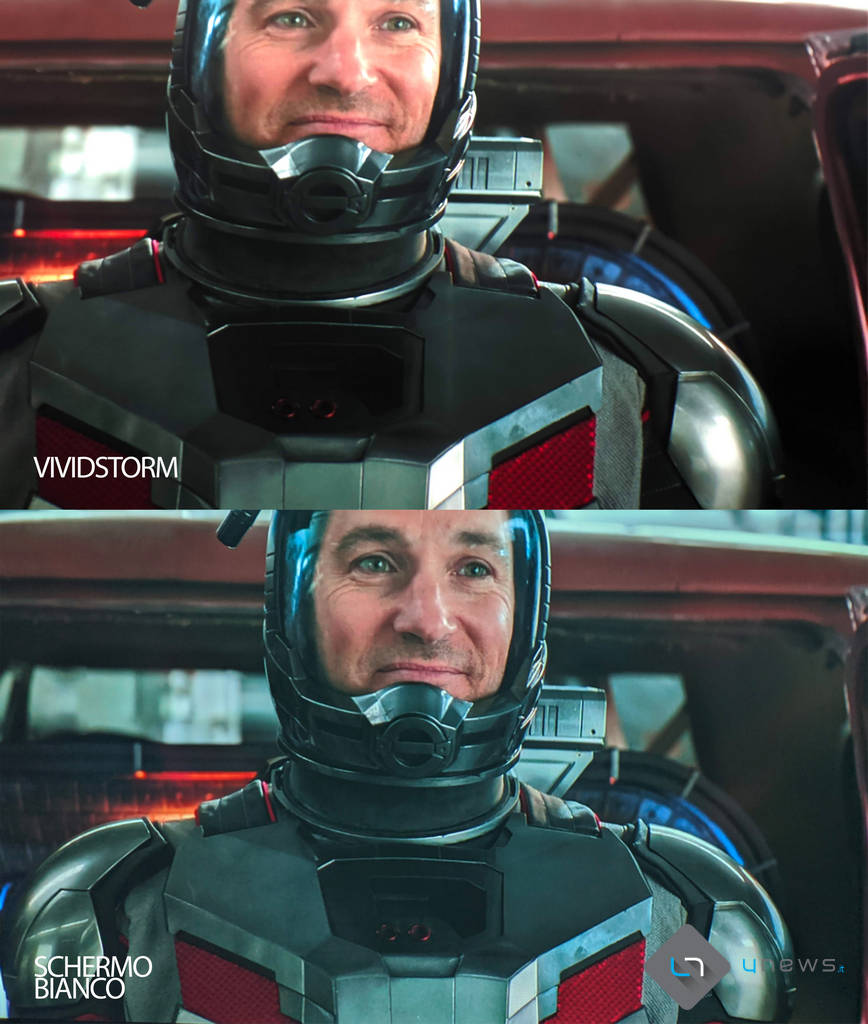 Absent, at least in our sample, the halos or “hotspots” or the even more annoying “glitter effect”, caused by the non homogeneous diffusion of reflective metal particles. The image has always an enviable uniformity even when you look at the screen from different angles, given a wide viewing angle of up to 170°. What is most striking, however, is the rendering of the blacks that are full and deep, especially if you use quality sources such as bluray and UHD BD: the merit is certainly the gray screen, but above all, the high light absorbing capacity of the material used by Vividstorm that is able to absorb all the “useful” light emitted by the projector lamp and deflect the disturbing one.
Absent, at least in our sample, the halos or “hotspots” or the even more annoying “glitter effect”, caused by the non homogeneous diffusion of reflective metal particles. The image has always an enviable uniformity even when you look at the screen from different angles, given a wide viewing angle of up to 170°. What is most striking, however, is the rendering of the blacks that are full and deep, especially if you use quality sources such as bluray and UHD BD: the merit is certainly the gray screen, but above all, the high light absorbing capacity of the material used by Vividstorm that is able to absorb all the “useful” light emitted by the projector lamp and deflect the disturbing one.
Below is another image that perhaps even more explicitly, shows the different color rendering with artificial light on between a traditional screen and the Vividstorm. Try to guess which is the white sheet…
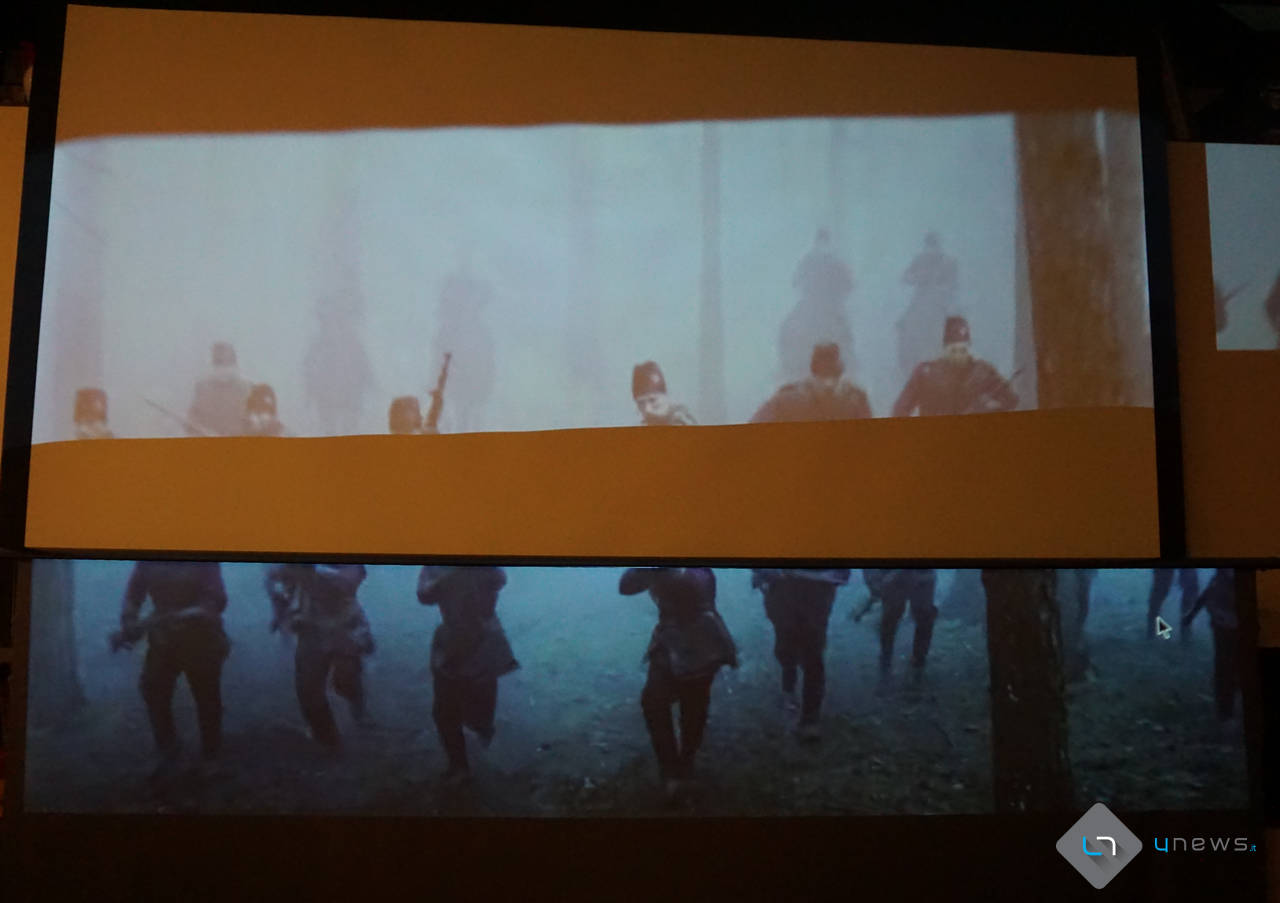 Conclusions
Conclusions
 Unduly underestimated when designing a home cinema system based on video projection for the first time, the screen is instead the first element that should be given attention. The correct and high quality screen, as in the case of the tested Vividstorm, is in fact able to improve the visual performance of even the cheapest projector and enhance the dynamic qualities of the most prominent projectors.
Unduly underestimated when designing a home cinema system based on video projection for the first time, the screen is instead the first element that should be given attention. The correct and high quality screen, as in the case of the tested Vividstorm, is in fact able to improve the visual performance of even the cheapest projector and enhance the dynamic qualities of the most prominent projectors.
The cinematic experience using a Vividstorm screen is sublimated, with vivid, bright colors and deep blacks that enhance immersion in a way that’s hard to describe and never happened before (try Life of Pi to Believe). However, even the casual use, maybe with the lights on, or in broad daylight, to watch the traditional sunday soccer game, is surprising, giving our video projection space a flexibility that we would never have imagined. That’s why we can give the Vividstorm screen our highest award: the gold award.
Further informations on Vividstorm at this address:
Amazon:
Vividstorm screens US – https://www.amazon.com/vividstormsince2004
Vividstorm screens CA – https://www.amazon.ca/vividstormsince2004
Alibaba: https://vividstorm.en.alibaba.com/
VIVIDSTORM company: http://www.vividstormscreens.com/
Facebook: http://t.cn/AiHXmesF

